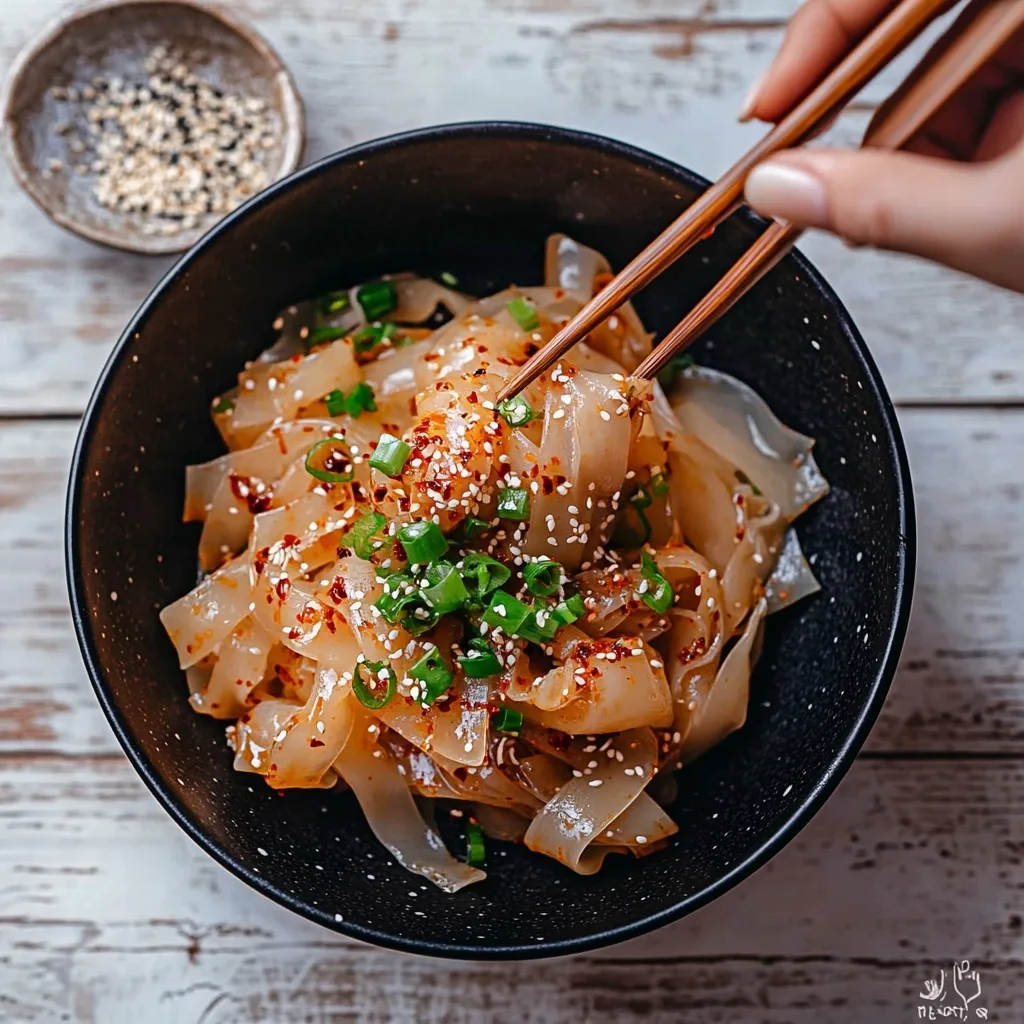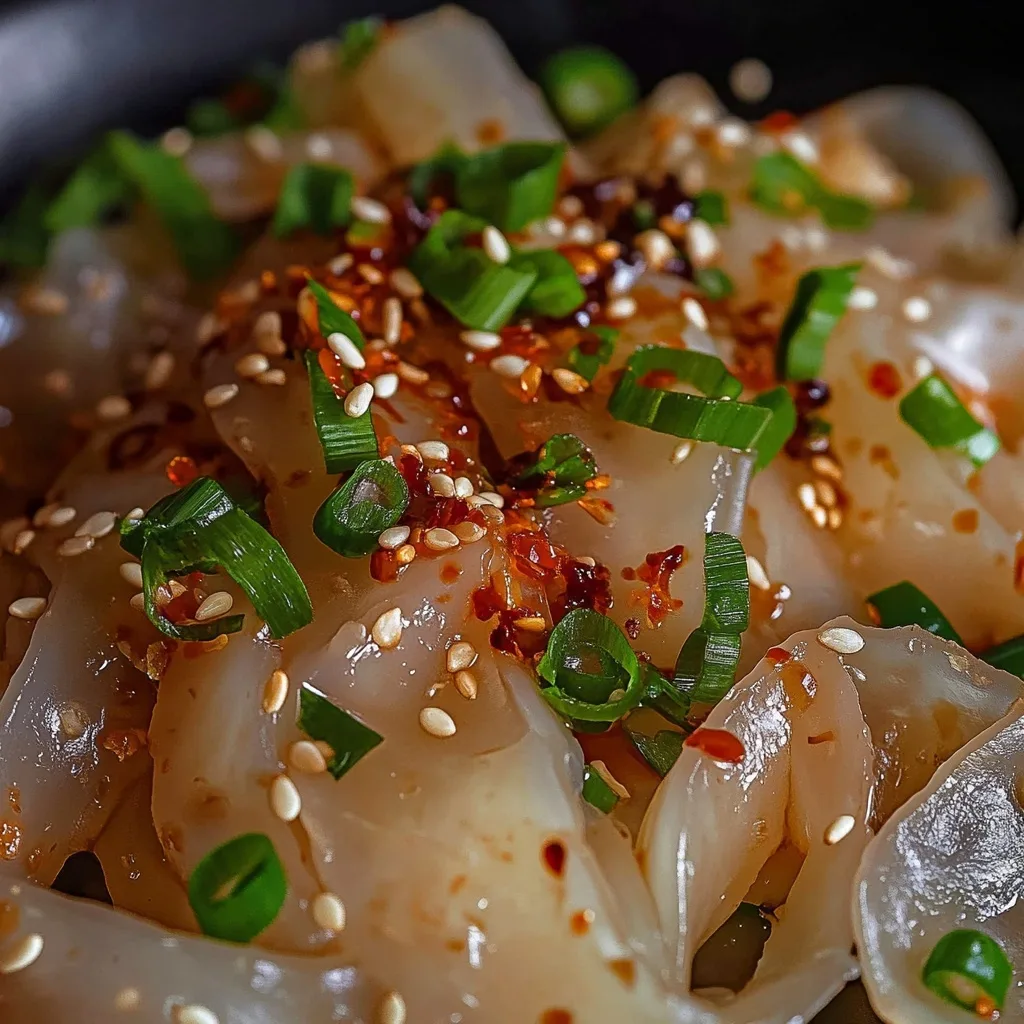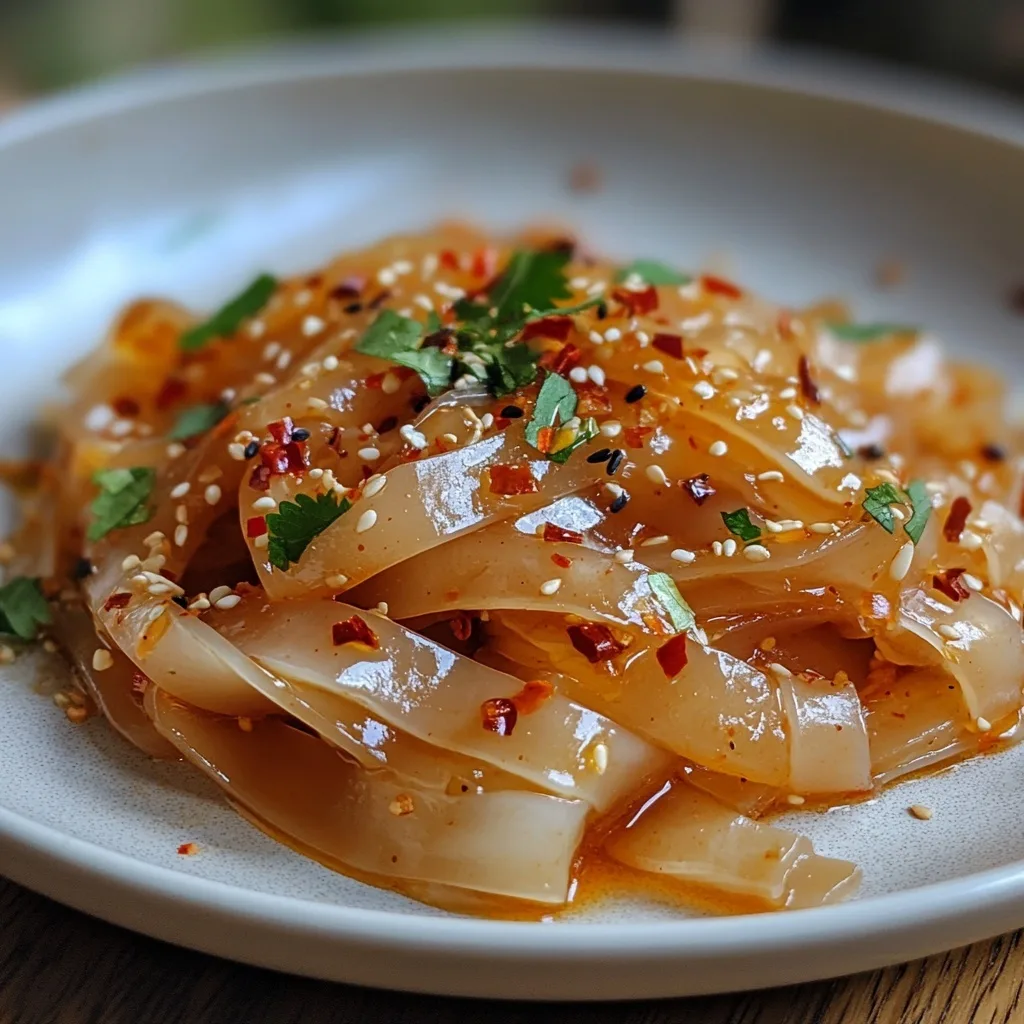Rice noodle paper, often seen in Asian-inspired noodles and spring rolls, is more than just a wrap—it’s a chewy, gluten-free, and highly versatile pantry staple. In this guide, we’ll walk you through what rice noodle paper is, how it compares to chewy rice noodles, creative no-cook noodle recipes, its health benefits, and even halal suitability.
You’ll discover how to transform rice paper sheets into a toothsome and springy vegan noodle dish, master storage hacks, and answer your most Googled questions. Whether you’re chasing that perfect sticky noodle texture or experimenting with homemade chili oil, we’ve got you covered.
Looking for inspiration? Try our Taste Air Fryer Rice Paper Noodle Rolls for a crispy twist.

Explore the Steps
Understanding Rice Noodle Paper Basics
What Is Rice Noodle Paper?
Rice noodle paper, also known simply as rice paper, is a thin edible sheet made from a blend of rice flour, water, and sometimes tapioca starch. It’s naturally gluten-free, making it ideal for individuals with gluten sensitivity or those following gluten-free diets.
Originating in Vietnam and spreading across Southeast Asia, this translucent sheet becomes pliable when soaked and is often used to make spring rolls. However, it’s also a rising star in no-cook noodle recipes, where it takes on a soft, chewy texture.
This gluten-free rice paper offers a mild taste that pairs well with bold ingredients like chili oil, herbs, and soy-based sauces, creating the perfect base for Asian-inspired noodles.
Difference Between Rice Noodle Paper and Chewy Rice Noodles
At a glance, rice noodle paper and traditional rice noodles might seem interchangeable—but they’re not. Here’s how they differ:
| Feature | Rice Noodle Paper | Chewy Rice Noodles |
|---|---|---|
| Shape/Form | Thin sheets | Strips or flat noodles |
| Preparation | Soak in water | Boil in hot water |
| Texture (After Prep) | Sticky, chewy, soft | Toothsome and springy |
| Common Usage | Rolls, wraps, no-cook recipes | Stir-fries, soups, pad thai |
Rice paper offers a quicker and lighter alternative to traditional noodles and is perfect for a quick rice paper hack when you’re short on time or stovetop space.
Common Uses in Asian-Inspired Noodles & Dishes
Rice noodle paper has evolved far beyond the classic Vietnamese spring roll. Modern cooks and food bloggers are getting creative, crafting vegan noodle dishes and sticky rice paper noodles that showcase both versatility and flavor. Popular dishes include:
- Cold noodle bowls: With soaked rice paper strips and soy-lime dressing
- Sichuan-style flavor stir-ins: With garlic, sesame oil, and chili crunch
- Rice paper “pasta”: Tossed with homemade chili oil and scallions
- Air-fried rice paper chips: Crisped up for a gluten-free snack
Don’t miss our full recipe on Pumpkin Butter Mochi Hawaii Recipe to get inspired by Asian flavors with a twist.
This adaptability has made rice paper a go-to for quick dinners, meal preps, and healthy gluten-free cooking—even for beginners.
PrintRice Noodle Paper – The Ultimate Guide to Quick, Chewy & Gluten-Free Creations
A quick and chewy no-cook rice noodle dish using soaked rice paper, tossed in spicy chili oil and garnished with sesame seeds and scallions. Perfect for vegan, gluten-free, and Asian-inspired meals in under 15 minutes.
- Prep Time: 10 minutes
- Cook Time: 0 minutes
- Total Time: 10 minutes
- Yield: 2 servings
- Category: Lunch, Dinner, Vegan
- Method: No-Cook, Soak & Toss
- Cuisine: Asian-inspired
- Diet: Gluten Free
Ingredients
2 sheets of rice noodle paper
1 tsp sesame oil
1 tsp low-sodium soy sauce
1 tbsp homemade chili oil (or store-bought)
½ small cucumber, julienned
½ carrot, shredded
2 tbsp chopped scallions
1 tsp toasted sesame seeds
Optional: red chili flakes, mint leaves, or lime wedge for garnish
Instructions
Soak the rice paper sheets
Fill a shallow dish or pan with room temperature water. Gently soak each rice paper sheet for 10–15 seconds, just until it becomes soft and pliable.Slice into noodle strips
Place the softened sheets onto a clean cutting board. Using a sharp knife or kitchen scissors, slice them into thin strips to resemble noodles.Transfer to a mixing bowl
Carefully move the sliced rice paper noodles into a large bowl, keeping them from sticking together.Add sauces and toss
Pour in the sesame oil, soy sauce, and chili oil. Use chopsticks or tongs to gently toss until the noodles are evenly coated and glossy.Add fresh vegetables and herbs
Mix in julienned cucumber, shredded carrot, and chopped fresh herbs like mint or cilantro.Garnish and finish
Sprinkle with toasted sesame seeds and extra red chili flakes for added crunch and heat.Serve and enjoy
Serve the rice noodle paper salad cold or lightly warmed for a chewy, satisfying, and gluten-free noodle experience.
Notes
Do not oversoak the rice paper or it will become mushy.
For a cold noodle salad, chill ingredients before serving.
Add protein like tofu or tempeh for a complete meal.
Great for meal prep—just store sauce separately to prevent sogginess.
How to Cook and Use Rice Noodle Paper Creatively
The Quick Rice Paper Hack for No-Cook Noodle Recipes
Craving noodles but don’t want to boil water? Here’s a quick rice paper hack that turns basic rice sheets into a full-blown noodle experience in minutes—without heat.
Step-by-step:
- Soak one sheet of gluten-free rice paper in room temperature water for 10–15 seconds.
- Place the soaked sheet on a damp cutting board.
- Using a pizza cutter or kitchen shears, slice it into thin strips (like fettuccine).
- Toss in sesame oil or soy sauce to keep from sticking.
Voilà! You now have chewy rice noodles ready to be served cold with veggies, or gently warmed in a sauce. These no-cook noodles are toothsome and springy, making them ideal for vegan noodle dishes, light lunch bowls, or spicy Sichuan-style flavor meals.
Check out our twist on savory snacks in this guide to Chickpea Flour Cookies—a great gluten-free pairing with your noodles.
Air-Fried vs. Soaked: Cooking Methods & Sticky Texture Tips
Let’s talk texture. The magic of rice noodle paper lies in its ability to change based on how it’s treated. Want it soft and slurpy? Or crackly and crispy? Here’s how:
| Method | Texture Outcome | Best Used For |
|---|---|---|
| Soaked (10–20s) | Sticky, chewy, elastic | Noodles, wraps, dumpling alternatives |
| Air-fried | Light, crisp, golden | Snacks, rice paper chips, wraps |
| Pan-fried | Slightly crisp edges, chewy | Stir-fries, layered noodle lasagna |
Tips to master the sticky noodle texture:
- Soak rice paper only until pliable—don’t overdo it or it’ll tear.
- Lightly oil or sauce your “noodles” right after slicing to prevent clumping.
- Want a chewy but firm bite? Stack two sheets before slicing.
Discover great ideas like Cherry Pistachio Chocolate Yogurt Protein Bark to explore flavor layering beyond savory.
How to Make a Vegan Noodle Dish with Rice Paper
Here’s how to build a flavorful, fully vegan noodle dish using rice paper strips:
Ingredients:
- 2 rice paper sheets
- 1 tbsp sesame oil
- 1 tsp soy sauce
- ½ cucumber, julienned
- 1 carrot, shredded
- Fresh mint & cilantro
- Drizzle of homemade chili oil
Instructions:
- Slice soaked rice paper into noodles.
- Toss with sesame oil and soy sauce for that sticky noodle texture.
- Add veggies and herbs.
- Top with a drizzle of spicy homemade chili oil for a Sichuan-style flavor kick.
This dish is ultra-light, packed with crunch, and perfect for warm days when you want something that’s fast, healthy, and doesn’t heat up your kitchen.

Is Rice Noodle Paper Healthy and Safe?
Is Rice Paper Good for You? Nutritional Breakdown
Yes, rice noodle paper is a healthy, low-calorie, and gluten-free option for meals and snacks. A single sheet of rice paper typically contains:
- 30–40 calories
- 0g fat
- 7–8g carbs
- No added sugar
- Gluten-free (if made from rice and water only)
It’s ideal for light meals, especially when filled or topped with vegetables, tofu, or lean proteins. Since it’s made from minimal ingredients—usually just rice flour and water—there are no hidden preservatives, making it a cleaner alternative to other wraps or noodles.
For those with gluten intolerance or on a plant-based diet, it’s a great option. You can learn more about its health benefits from this resource on Healthline.
Gluten-Free Rice Paper vs. Other Wrappers
Let’s compare rice paper to other popular wrappers and noodle bases:
| Type | Gluten-Free | Vegan | Calories | Texture |
|---|---|---|---|---|
| Rice Noodle Paper | Yes | Yes | Low | Chewy, sticky, soft |
| Wonton Wrappers | No | Often No | Med | Thin, doughy |
| Lettuce Wraps | Yes | Yes | Very Low | Crunchy |
| Egg Noodles | No | No | High | Soft, elastic |
Gluten-free rice paper is the most versatile in terms of usage, storage, and dietary friendliness. It easily replaces egg noodles in stir-fries or acts as a thin noodle layer in layered dishes.
If you’re creating a vegan noodle dish, rice paper strips pair well with tofu, edamame, mushrooms, and even shredded cabbage for added crunch.
Looking for cozy gluten-free baking? Don’t miss our Gluten-Free Japanese Milk Bread—soft, fluffy, and allergy-friendly.
Is Rice Paper Halal, Vegan, and Safe to Eat Raw?
Yes to all three. Here’s why:
- Halal? Most rice papers are halal by default since they’re made only with rice, water, and occasionally tapioca starch. However, always check labels for brands that add seasonings or flavorings.
- Vegan? 100%. No animal ingredients are involved.
- Raw-safe? Definitely. Rice paper doesn’t need to be cooked to be consumed. In fact, most summer rolls use it raw after a brief soak.
However, when you’re using it as noodles, a soak or quick pan-fry improves texture and flavor dramatically.
The sticky noodle texture that comes from a properly soaked rice paper strip can rival traditional cooked pasta—especially when combined with a chili-laced Sichuan-style flavor profile.

Tips, Storage, and Rice Paper FAQs
How to Store Rice Noodle Paper for Maximum Freshness
Rice paper sheets are delicate and prone to cracking when exposed to air or humidity. To maintain their toothsome and springy quality, proper storage is key—especially if you buy in bulk.
Storing unopened rice paper:
- Keep in a cool, dry place (pantry preferred)
- Avoid direct sunlight or high moisture
- Lay flat to prevent curling
Storing opened rice paper:
- Place sheets in an airtight container or resealable bag
- Add a silica packet to control humidity
- Use within 3–4 weeks for best quality
Once soaked, leftover rice noodle paper “noodles” should be kept in a sealed container in the fridge and consumed within 24 hours for optimal sticky noodle texture.
Expert Tips for Asian-Inspired Meals with Rice Paper
Rice paper is like a blank canvas. These quick pro-tips will take your Asian-inspired noodles or wraps to the next level:
- Layer flavors: Add fresh herbs like Thai basil or mint between sheets before slicing into noodles.
- Upgrade the sauce: Mix up your own homemade chili oil using sesame seeds, garlic, soy sauce, and red pepper flakes.
- Fry with caution: If you’re air frying or pan-frying, lightly mist with oil to prevent burning and maintain crunch.
Want bold flavor that doesn’t overpower? Combine Sichuan-style flavor (like chili oil or numbing pepper) with sweet soy or hoisin for balance.
Learn more about layering flavors in our Tigernut Flour Brownies—an unexpected but educational flavor-balance treat.
Sticky, Chewy, or Crisp? Texture Control Tips
Whether you’re crafting noodles, wraps, or snacks, here’s how to control your rice paper’s texture:
| Desired Texture | Method | Pro Tip |
|---|---|---|
| Sticky/Chewy | Soak 10–15 seconds | Use cold water to slow softening |
| Springy | Double layer before slicing | Toss with sesame oil after cutting |
| Crispy | Air-fry or pan-fry for 3–4 mins | Mist lightly with oil before cooking |
To avoid rubbery results, don’t oversoak—a little resistance makes for a better chew and easier slicing.
Frequently Asked Questions
Are rice paper noodles healthy?
Yes! They’re low in fat, gluten-free, and made from whole ingredients like rice flour and water. They’re also great in vegan and low-calorie recipes.
Can I use rice paper as noodles?
Absolutely. It’s one of the best quick rice paper hacks out there. Soak the sheet, slice it, and toss in sauce—done!
Is rice paper okay to eat?
Yes. It’s edible raw, soaked, or cooked. As long as it’s stored properly and not expired, it’s perfectly safe.
What is the paper made out of rice?
It’s primarily made from rice flour, water, and salt. Some brands add tapioca starch for flexibility.
Is rice paper halal?
Yes, standard rice paper is halal. Just make sure no animal-derived additives or sauces are included in pre-seasoned versions.
How strong is rice paper?
Dry, it’s brittle. Once soaked, it becomes stretchy, chewy, and durable—perfect for spring rolls or as homemade noodles.

